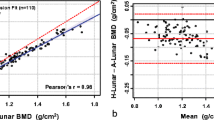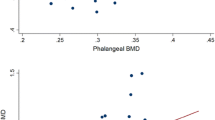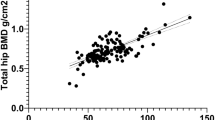Abstract
Objective
We evaluated the correlation of the absolute bone mineral density (BMD) values of the lumbar spine and standard sites of the proximal femur obtained from a Lunar Prodigy and the newly developed pencil-beam dual-energy X-ray absorptiometry (Dexxum).
Materials and methods
Between June 2008 and December 2008, 79 Korean volunteers were enrolled. Measurements were obtained on the same day using both densitometers. The absolute BMD values (g/cm2) from the two densitometers were evaluated using Pearson’s correlation analysis with Bonferroni’s correction for the three clinically important sites. In order to evaluate precision, we performed duplicate Dexxum measurements, and calculated the within-subject coefficient of variation (WSCV).
Results
The Pearson’s correlation coefficient (r) of BMD values for the total proximal femur, femoral neck, and lumbar spine by the two densitometers were 0.926, 0.948, and 0.955 respectively, and the null hypotheses of r = 0.8 were all rejected (p < 0.001 by one-sided Z-test with Fisher’s z-transformation for each site). The T-scores (r ≧ 0.842) and Z-scores (r ≧ 0.709) also showed strong positive correlations. The duplicate BMD values of Dexxum showed a high level of precision (WSCV ≦ 4.27%).
Conclusion
Dexxum measurements of BMD, T-scores, and Z-scores showed a strong linear correlation with those measured on Lunar Prodigy.


Similar content being viewed by others
References
Hamdy RC, Petak SM, Lenchik L. Which central dual X-ray absorptiometry skeletal sites and regions of interest should be used to determine the diagnosis of osteoporosis? J Clin Densitom 2002;5 Suppl:S11–8
Miller PD, Bonnick SL, Rosen CJ. Consensus of an international panel on the clinical utility of bone mass measurements in the detection of low bone mass in the adult population. Calcif Tissue Int. 1996;58:207–14.
Kanis JA, Melton LJ III, Christiansen C, Johnston CC, Khaltaev N. The diagnosis of osteoporosis. J Bone Miner Res. 1994;9:1137–41.
Blake GM, Harrison EJ, Adams JE. Dual X-ray absorptiometry: cross-calibration of a new fan-beam system. Calcif Tissue Int. 2004;75:7–14.
Genant HK, Grampp S, Gluer CC, et al. Universal standardization for dual x-ray absorptiometry: patient and phantom cross-calibration results. J Bone Miner Res. 1994;9:1503–14.
Laskey MA, Flaxman ME, Barber RW, et al. Comparative performance in vitro and in vivo of Lunar DPX and Hologic QDR-1000 dual energy X-ray absorptiometers. Br J Radiol. 1991;64:1023–9.
Pocock NA, Noakes KA, Griffiths M, et al. A comparison of longitudinal measurements in the spine and proximal femur using lunar and hologic instruments. J Bone Miner Res. 1997;12:2113–8.
Pocock NA, Sambrook PN, Nguyen T, Kelly P, Freund J, Eisman JA. Assessment of spinal and femoral bone density by dual X-ray absorptiometry: comparison of lunar and hologic instruments. J Bone Miner Res. 1992;7:1081–4.
Svendsen OL, Marslew U, Hassager C, Christiansen C. Measurements of bone mineral density of the proximal femur by two commercially available dual energy X-ray absorptiometric systems. Eur J Nucl Med. 1992;19:41–6.
Quan H, Shih WJ. Assessing reproducibility by the within-subject coefficient of variation with random effects models. Biometrics. 1996;52:1195–203.
Faulkner KG, Gluer CC, Estilo M, Genant HK. Cross-calibration of DXA equipment: upgrading from a Hologic QDR 1000/W to a QDR 2000. Calcif Tissue Int. 1993;52:79–84.
Hui SL, Gao S, Zhou XH, et al. Universal standardization of bone density measurements: a method with optimal properties for calibration among several instruments. J Bone Miner Res. 1997;12:1463–70.
Kalender WA, Felsenberg D, Genant HK, Fischer M, Dequeker J, Reeve J. The European Spine Phantom—a tool for standardization and quality control in spinal bone mineral measurements by DXA and QCT. Eur J Radiol. 1995;20:83–92.
Lu Y, Fuerst T, Hui S, Genant HK. Standardization of bone mineral density at femoral neck, trochanter and Ward’s triangle. Osteoporos Int. 2001;12:438–44.
Hanson J. Standardization of proximal femur BMD measurements. International Committee for Standards in Bone Measurement. Osteoporos Int. 1997;7:500–1.
Oldroyd B, Smith AH, Truscott JG. Cross-calibration of GE/Lunar pencil and fan-beam dual energy densitometers—bone mineral density and body composition studies. Eur J Clin Nutr. 2003;57:977–87.
Ozdemir A, Ucar M. Standardization of spine and hip BMD measurements in different DXA devices. Eur J Radiol. 2007;62:423–6.
Faulkner KG, Roberts LA, McClung MR. Discrepancies in normative data between Lunar and Hologic DXA systems. Osteoporos Int. 1996;6:432–6.
Cui LH, Choi JS, Shin MH, et al. Prevalence of osteoporosis and reference data for lumbar spine and hip bone mineral density in a Korean population. J Bone Miner Metab. 2008;26:609–17.
Gluer CC, Steiger P, Selvidge R, Elliesen-Kliefoth K, Hayashi C, Genant HK. Comparative assessment of dual-photon absorptiometry and dual-energy radiography. Radiology. 1990;174:223–8.
Wilson CR, Fogelman I, Blake GM, Rodin A. The effect of positioning on dual energy X-ray bone densitometry of the proximal femur. Bone Miner. 1991;13:69–76.
Leslie WD, Moayyeri A. Minimum sample size requirements for bone density precision assessment produce inconsistency in clinical monitoring. Osteoporos Int. 2006;17:1673–80.
Acknowledgement
This study was supported by a grant of the Korea Healthcare technology R&D Project, Ministry of Health, Welfare & Family Affairs, Republic of Korea (A084152).
Author information
Authors and Affiliations
Corresponding author
Rights and permissions
About this article
Cite this article
Choi, D., Kim, DY., Han, C.S. et al. Measurements of bone mineral density in the lumbar spine and proximal femur using lunar prodigy and the new pencil-beam dual-energy X-ray absorptiometry. Skeletal Radiol 39, 1109–1116 (2010). https://doi.org/10.1007/s00256-009-0828-1
Received:
Revised:
Accepted:
Published:
Issue Date:
DOI: https://doi.org/10.1007/s00256-009-0828-1




